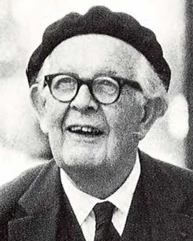
Developmental psychology is the scientific study of how and why humans grow, change, and adapt across the course of their lives. Originally concerned with infants and children, the field has expanded to include adolescence, adult development, aging, and the entire lifespan. Developmental psychologists aim to explain how thinking, feeling, and behaviors change throughout life. This field examines change across three major dimensions, which are physical development, cognitive development, and social emotional development. Within these three dimensions are a broad range of topics including motor skills, executive functions, moral understanding, language acquisition, social change, personality, emotional development, self-concept, and identity formation.

Jean William Fritz Piaget was a Swiss psychologist known for his work on child development. Piaget's theory of cognitive development and epistemological view are together called genetic epistemology.
A cognitive model is a representation of one or more cognitive processes in humans or other animals for the purposes of comprehension and prediction. There are many types of cognitive models, and they can range from box-and-arrow diagrams to a set of equations to software programs that interact with the same tools that humans use to complete tasks. In terms of information processing, cognitive modeling is modeling of human perception, reasoning, memory and action.
Object permanence is the understanding that whether an object can be sensed has no effect on whether it continues to exist. This is a fundamental concept studied in the field of developmental psychology, the subfield of psychology that addresses the development of young children's social and mental capacities. There is not yet scientific consensus on when the understanding of object permanence emerges in human development.

Piaget's theory of cognitive development, or his genetic epistemology, is a comprehensive theory about the nature and development of human intelligence. It was originated by the Swiss developmental psychologist Jean Piaget (1896–1980). The theory deals with the nature of knowledge itself and how humans gradually come to acquire, construct, and use it. Piaget's theory is mainly known as a developmental stage theory.
Cognitive development is a field of study in neuroscience and psychology focusing on a child's development in terms of information processing, conceptual resources, perceptual skill, language learning, and other aspects of the developed adult brain and cognitive psychology. Qualitative differences between how a child processes their waking experience and how an adult processes their waking experience are acknowledged. Cognitive development is defined as the emergence of the ability to consciously cognize, understand, and articulate their understanding in adult terms. Cognitive development is how a person perceives, thinks, and gains understanding of their world through the relations of genetic and learning factors. There are four stages to cognitive information development. They are, reasoning, intelligence, language, and memory. These stages start when the baby is about 18 months old, they play with toys, listen to their parents speak, they watch TV, anything that catches their attention helps build their cognitive development.

Egocentrism refers to difficulty differentiating between self and other. More specifically, it is difficulty in accurately perceiving and understanding perspectives other than one's own. Egocentrism is found across the life span: in infancy, early childhood, adolescence, and adulthood. Although egocentric behaviors are less prominent in adulthood, the existence of some forms of egocentrism in adulthood indicates that overcoming egocentrism may be a lifelong development that never achieves completion. Adults appear to be less egocentric than children because they are faster to correct from an initially egocentric perspective than children, not because they are less likely to initially adopt an egocentric perspective.
Linda B. Smith is an American developmental psychologist internationally recognized for her theoretical and empirical contributions to developmental psychology and cognitive science, proposing, through theoretical and empirical studies, a new way of understanding developmental processes. Smith's works are groundbreaking and illuminating for the field of perception, action, language, and categorization, showing the unique flexibility found in human behavior. She has shown how perception and action are ways of obtaining knowledge for cognitive development and word learning.

Peekaboo is a form of play played with an infant. To play, one player hides their face, pops back into the view of the other, and says Peekaboo!, sometimes followed by I see you! There are many variations: for example, where trees are involved, "Hiding behind that tree!" is sometimes added. Another variation involves saying "Where's the baby?" while the face is covered and "There's the baby!" when uncovering the face.
In psychology, centration is the tendency to focus on one salient aspect of a situation and neglect other, possibly relevant aspects. Introduced by the Swiss psychologist Jean Piaget through his cognitive-developmental stage theory, centration is a behaviour often demonstrated in the preoperational stage. Piaget claimed that egocentrism, a common element responsible for preoperational children's unsystematic thinking, was causal to centration. Research on centration has primarily been made by Piaget, shown through his conservation tasks, while contemporary researchers have expanded on his ideas.
Child development stages are the theoretical milestones of child development, some of which are asserted in nativist theories. This article discusses the most widely accepted developmental stages in children. There exists a wide variation in terms of what is considered "normal", caused by variations in genetic, cognitive, physical, family, cultural, nutritional, educational, and environmental factors. Many children reach some or most of these milestones at different times from the norm.
Domain-general learning theories of development suggest that humans are born with mechanisms in the brain that exist to support and guide learning on a broad level, regardless of the type of information being learned. Domain-general learning theories also recognize that although learning different types of new information may be processed in the same way and in the same areas of the brain, different domains also function interdependently. Because these generalized domains work together, skills developed from one learned activity may translate into benefits with skills not yet learned. Another facet of domain-general learning theories is that knowledge within domains is cumulative, and builds under these domains over time to contribute to our greater knowledge structure. Psychologists whose theories align with domain-general framework include developmental psychologist Jean Piaget, who theorized that people develop a global knowledge structure which contains cohesive, whole knowledge internalized from experience, and psychologist Charles Spearman, whose work led to a theory on the existence of a single factor accounting for all general cognitive ability.
Infant cognitive development is the first stage of human cognitive development, in the youngest children. The academic field of infant cognitive development studies of how psychological processes involved in thinking and knowing develop in young children. Information is acquired in a number of ways including through sight, sound, touch, taste, smell and language, all of which require processing by our cognitive system. However, cognition begins through social bonds between children and caregivers, which gradually increase through the essential motive force of Shared intentionality. The notion of Shared intentionality describes unaware processes during social learning at the onset of life when organisms in the simple reflexes substage of the sensorimotor stage of cognitive development do not maintain communication via the sensory system.
Ideational apraxia (IA) is a neurological disorder which explains the loss of ability to conceptualize, plan, and execute the complex sequences of motor actions involved in the use of tools or otherwise interacting with objects in everyday life. Ideational apraxia is a condition in which an individual is unable to plan movements related to interaction with objects, because they have lost the perception of the object's purpose. Characteristics of this disorder include a disturbance in the concept of the sequential organization of voluntary actions. The patient appears to have lost the knowledge or thought of what an object represents. This disorder was first seen 100 years ago by Doctor Arnold Pick, who described a patient who appeared to have lost their ability to use objects. The patient would make errors such as combing their hair with the wrong side of the comb or placing a pistol in his mouth. From that point on, several other researchers and doctors have stumbled upon this unique disorder. IA has been described under several names such as, agnosia of utilization, conceptual apraxia or loss of knowledge about the use of tools, or Semantic amnesia of tool usage. The term apraxia was first created by Steinthal in 1871 and was then applied by Gogol, Kusmaul, Star, and Pick to patients who failed to pantomime the use of tools. It was not until the 1900s, when Liepmann refined the definition, that it specifically described disorders that involved motor planning, rather than disturbances in the patient’s visual perception, language, or symbolism.
Renée Baillargeon is a Canadian American research psychologist. A distinguished professor of Psychology at the University of Illinois Urbana-Champaign, Baillargeon specializes in the development of cognition in infancy. Educated at McGill University and the University of Pennsylvania, Baillargeon is the recipient of the American Psychological Association's Boyd R. McCandless Young Scientist Award.
Neo-Piagetian theories of cognitive development criticize and build upon Jean Piaget's theory of cognitive development.
Esther Thelen was an expert in the field of developmental psychology. Thelen's research was focused on human development, especially in the area of infant development.
Representational insight is the ability to detect and mentally represent the relation between a symbol and its referent. Whether or not a child gains this insight depends on the similarity between the symbol and its referent, the level of information provided about the relationship between the symbol and the referent, and a child's prior experience with symbols. An essential part of representational insight is dual representation or the existence of multiple mental representations of a single symbolic entity. Judy DeLoache coined this term after conducting many studies in which young children would watch an experimenter hide a toy in a model room and were then asked to retrieve a similar, but larger toy from a larger room.
Child lying refers to children displaying varying degrees of deceptive behavior in a social situation. Children have been observed lying as early as age 2 and their deceptive skills increase sharply as they mature into adolescence. Children who have advanced cognitive skills for their age have an increased tendency to begin lying at earlier ages. Children may lie for various reasons including, but not limited to, escaping punishment for not obeying a task, through observation of their parents and peers, or lacking a comprehensive understanding of basic morality.
Horizontal and vertical décalage are terms coined by developmental psychologist Jean Piaget, which he used to describe the four stages in Piaget's theory of cognitive development: sensorimotor, preoperational, concrete operations, and formal operations. According to Piaget, horizontal and vertical décalage generally occur during the concrete operations stage of development.




